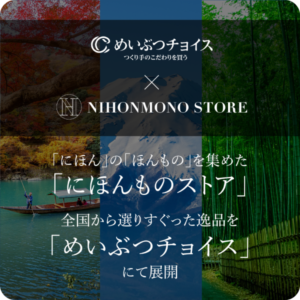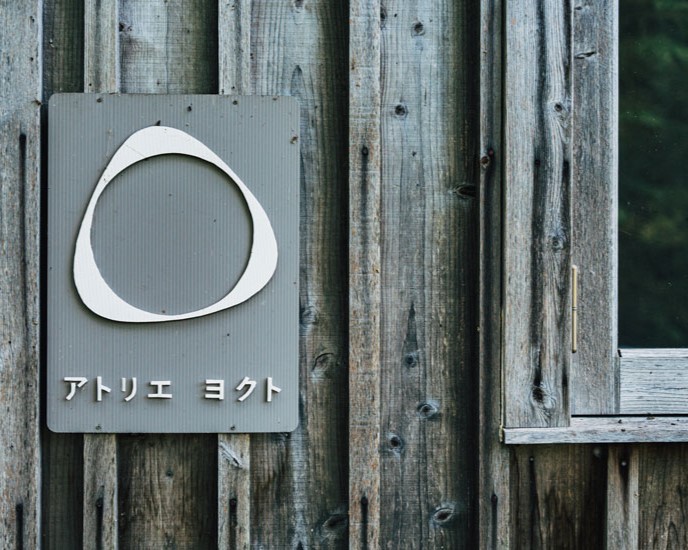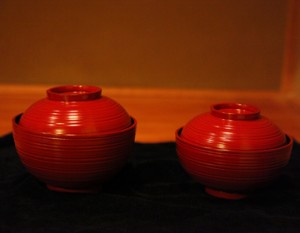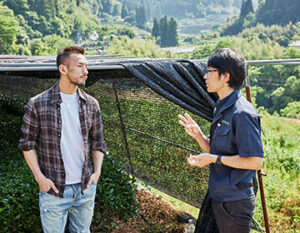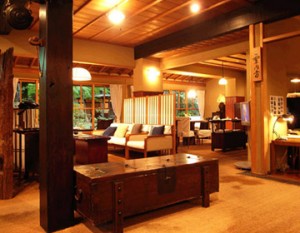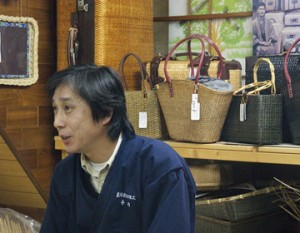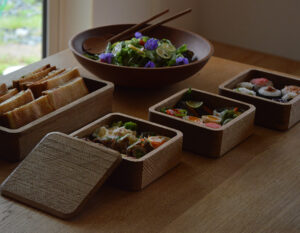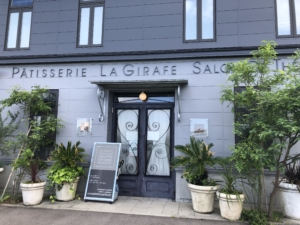The town of Hakushu in Hokuto City is surrounded by nature in all four seasons, with the Ojira River flowing through the town, fed by the Southern Alps and Kaikomagatake. It was living in Sweden that marked a turning point for the two designers and inspired them to establish their studio, Atelier Yokuto, here.
Products” born in our daily lives

Atelier YOKUTO, located in Hakushu, Hokuto City, Yamanashi Prefecture, is composed of Jun Furukawa, who handles everything from design to production, and Yuka Sato, who is in charge of graphic design for websites and packaging. They produce a wide range of products, including interior goods and furniture. “Our base is wood, but we hope to create products that can be used both indoors and outdoors,” says Furukawa, “by flexibly using materials suited to each purpose. The idea starts with “what we want,” and the design is refined through repeated prototyping to complete a “product. For example, a mini-sized cutting board can be used as a simple table for mountain climbing or camping, carried in a pocket or backpack, or used as a tray for cutting fruits and other items for daily use. It is one of the products that Furukawa, who loves the outdoors, came up with when he thought, “I want one of these. He says, “I first try to make things that I notice in my daily life and think are interesting. If I think it looks good, I brush it up and give it shape.
It has been nine years since they launched their brand, and 11 years since they moved to Hokuto City. They chose Hokuto City as the base of their activities because of its moderate distance from Tokyo and the familiarity of country life in Sweden, where they went to study abroad, and felt that “the climate and atmosphere are similar.
What they got in Sweden

They studied architecture at the same art university. After graduation, Mr. Furukawa worked as a carpenter at a traditional construction company before becoming independent and renting a factory in Sumida-ku, Tokyo, to produce custom-made furniture, but he felt his self-taught nature was limiting him. At the same time, his partner, Mr. Sato, had also been independent from a design firm for several years and felt stuck. Feeling the need to learn something new, the two decided to study in Sweden. Mr. Furukawa studied furniture design and Ms. Sato textiles at HDK University in Gothenburg, Sweden, for about four years. The fact that Sweden has a good education and social welfare system was reassuring to them when they were studying abroad and raising their newborn son.
Scandinavian furniture is attracting attention around the world, and Sweden is the birthplace of major furniture brand companies that have recently gained popularity in Japan. Swedish furniture is made of natural materials such as birch and oak, and is characterized by its excellent design and practicality. The comfort is that the design is smoothly incorporated into the product because of the rationality in terms of usability and the very close proximity between the designer and the production side. I saw the ideal I had envisioned for some time, and I thought again that I would cherish this relationship when I returned to Japan,” Furukawa recalls.
Ideas from traditional Japanese minka houses

In addition to the excellent design process of Swedish furniture, the brand concept was also influenced by a renewed awareness of the “goodness of Japan. The architecture and lifestyle of a foreign country made Mr. Furukawa rethink the “traditional Japanese minka” in depth. For example, the “tano-za-zukuri” style of traditional Japanese minka is usually divided by fusuma (sliding doors) or shoji (paper sliding doors), but by removing the partitions, the structure can be converted into one large space. In this way, the traditional Japanese minka is highly variable, and “I realized that the Japanese had a very rational way of living while flexibly accepting nature,” says Furukawa.
Most of the old Japanese furniture could be carried. If you put a chabudai on the floor, it becomes a living room for eating, and if you put a futon on the floor, it becomes a bedroom. Inspired by this, one of the concepts behind Atelier Yokuto’s products is that they are mobile and can be carried around.
The foldable table is easy to carry like a “chabudai,” and is also useful outdoors. Atelier JOKUTO’s products are a fusion of Scandinavian rationality and Japanese lifestyle, inspired by the traditional Japanese minka style that flexibly utilizes living space.
Newly proposed “Okamochi” in the modern age

The product they introduce is “Okamochi,” which they say “best embodies the brand concept. The traditional “Okamochi,” which was first used to carry meals during outdoor work such as rice planting and later used for delivery, has been redesigned in a modern way to store and carry daily tools. Its uses vary depending on the person using it, from serving meals at inns and hotels, including catering, to storing business tools for remote work, hair and makeup tools, sewing boxes, and more. The idea came about when he was living in Sweden and his children’s miniature cars were growing and he made them to help them learn to put them away. Mr. Furukawa recalls the time of development: “There are many boxes with handles in the world, but I was very impressed with Okamochi in Japan, where they were made to carry food.
With a focus on weight reduction, the product is made of paulownia wood, which has long been used as a lightweight material for chests of drawers and storage boxes, and aluminum for the handle. The Okamochi can be customized with a variety of options, including a shallow box and a lid that can also be used as a tray. The Okamochi is the basic module of Atelier Yokuto, and can be used in conjunction with other products. When we make small items, we design them with the idea that they will fit into this Okamochi. It’s fun to be able to use them in combination, because it opens up so many possibilities,” says Furukawa. Sato adds, “You can create unexpected combinations.
New Connections Expanded through “Monozukuri

Recently, they have been collaborating more and more with different industries. One such collaboration is with BEAU PAYSAGE, which produces unique natural wines in the Tsugane district of Hokuto City. BEAU PAYSAGE’s wines, which are made using natural farming methods and brewing with wild yeast, are distributed only to a limited number of markets and are not easily available. In addition to the quality of the wines, owner Eishi Okamoto’s philosophy of environmentally friendly, “hands-off” winemaking has won the hearts of connoisseurs in Japan and abroad, and is highly regarded. As part of BEAU PAYSAGE’s efforts, one barrel of empty wine barrels are upcycled into cutlery and other products every year, and this project has already been conducted for the fourth time. Okamoto said, “When you work alone, your ideas tend to be biased, so it is important to connect with various people.
The connection with Mr. Okamoto has further developed into a new collaboration with L’Effervescence, a French restaurant in Nishiazabu, Tokyo, on the occasion of its 10th anniversary. L’Effervescence, which incorporates traditional French techniques with Japan’s seasonal nature and culture to create cuisine with a unique aesthetic, is a restaurant that has earned three Michelin stars and is a hot topic among gastronomes. Chef Shinobu Namae’s order was for a knife rest that could hold both chopsticks and knives, using BEAU PAYSAGE wine barrels. Mr. Furukawa, who was actually involved in the design and production, said, “It is interesting and very instructive to make things while listening to people from different industries,” and then added, “I am now working in two directions: what I want to propose at Atelier Yokuto and what I want to make with someone through collaboration. This is one of the driving forces for me now,” he said, happily describing the positive impact on his work that responding to fresh ideas and needs has had.
Love the design

When the duo moved to Hokuto City, their brand had just been launched and was not well known, so they had to start from scratch and faced many difficulties not only in sales channels but also in procuring subcontractors and materials for production. Although Yamanashi seems to be rich in lumber resources, lumber mills in the prefecture handle softwoods such as cedar and cypress for building materials, but hardwood lumber suitable for furniture making is not commonly found. For this reason, they use domestic and imported timber from around Japan. In the past few years, a forestry company in Hokuto City, where the studio is located, has opened a logging market for woodworkers in the area, using wood from logs that had previously been used for chips or firewood, and logs are now available. However, the logs cannot be used in the production process in their raw, moist state, so they are made into boards at a sawmill in the city, and then trucks must be rented to and from Nagano Prefecture to dry the boards. There are many issues to be addressed in terms of efficiency and cost in the cycle from procurement of lumber to sawmilling, and Furukawa feels that it is necessary to establish a cooperative system with local competitors and lumber dealers. This movement is led by a woodworker friend of his, and is still working on the issues and expanding further.
In the production process, some parts are outsourced, but Furukawa feels that there are issues regarding the volume of production.
If we could increase the number of subcontractors, we would be able to devote more time to product development. After all, I love design.
Atelier YOKUTO’s concept of “monozukuri

I don’t want to define my style or vision too much. I hope that you can sense my intentions in the products I will create in the future.
This is typical of Furukawa, who is known for his flexible approach to manufacturing and ideas that come to him in the course of daily life. For example, the wall storage furniture, which allows users to freely create storage space by installing iron bars with hooks on the wall and hooking various sizes of boxes and shelves to them, was actually incorporated into his own residence, which Sato designed four years ago. The wall storage furniture was actually installed in Sato’s own residence, which he designed and built four years ago. “Actually using the furniture has given me new ideas,” says Furukawa, who is enjoying the new idea of freely arranging his home space with furniture.
Products that come alive when used

I am not interested in making things that already exist, so I will only give shape to things that I feel are meaningful to make that have not yet been discovered.
Mr. Furukawa’s free and flexible ideas for new products based on his own life gave us a glimpse of the future possibilities of “monozukuri.
The two call Atelier Yokuto’s products, with their combinable modules and customizability, “furniture with the user’s participation. We want to create products that allow the user’s ideas and concepts to come to life freely,” they said. They design their products not by considering the “form” of the product, but by considering “devices” that do not hinder the possibilities of how the product can be used. When a product reaches the customer and is used in a way they did not intend, they feel happy that they have “communicated with the user through the product. Atelier Yokuto’s goal is not to own things, but to design products that enrich people’s lives through their use. We are sure that we will be surprised by the unexpected hints hidden in their products.

